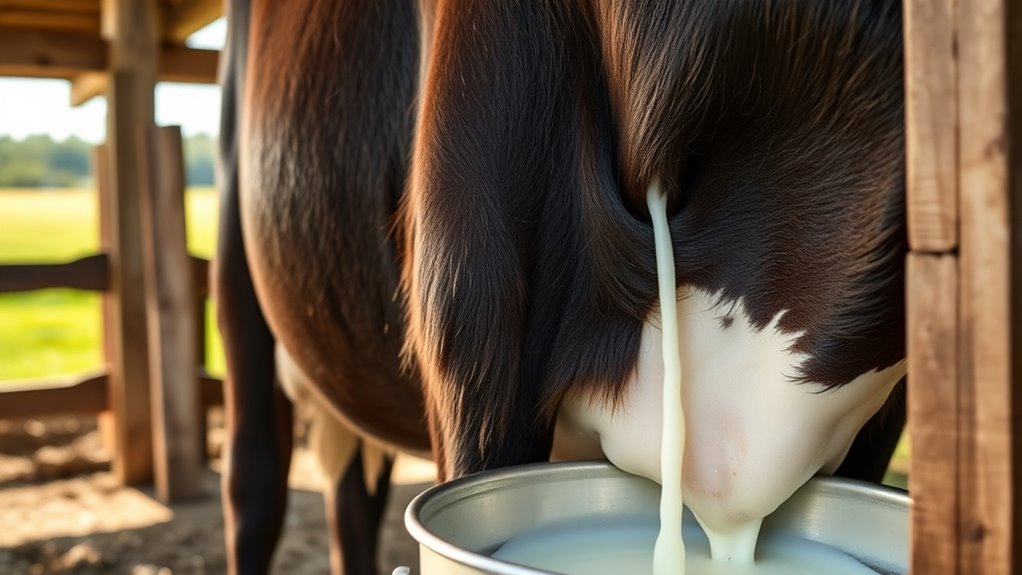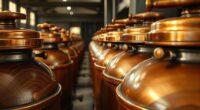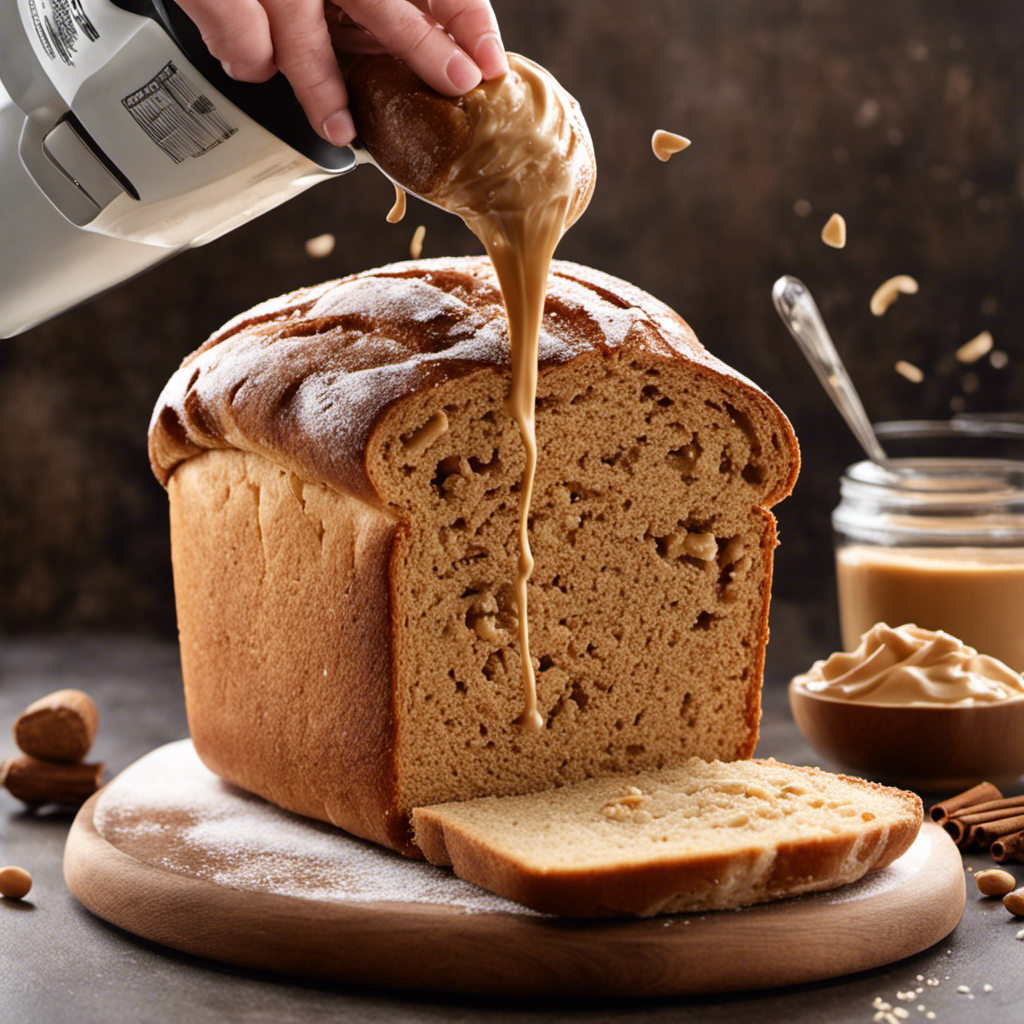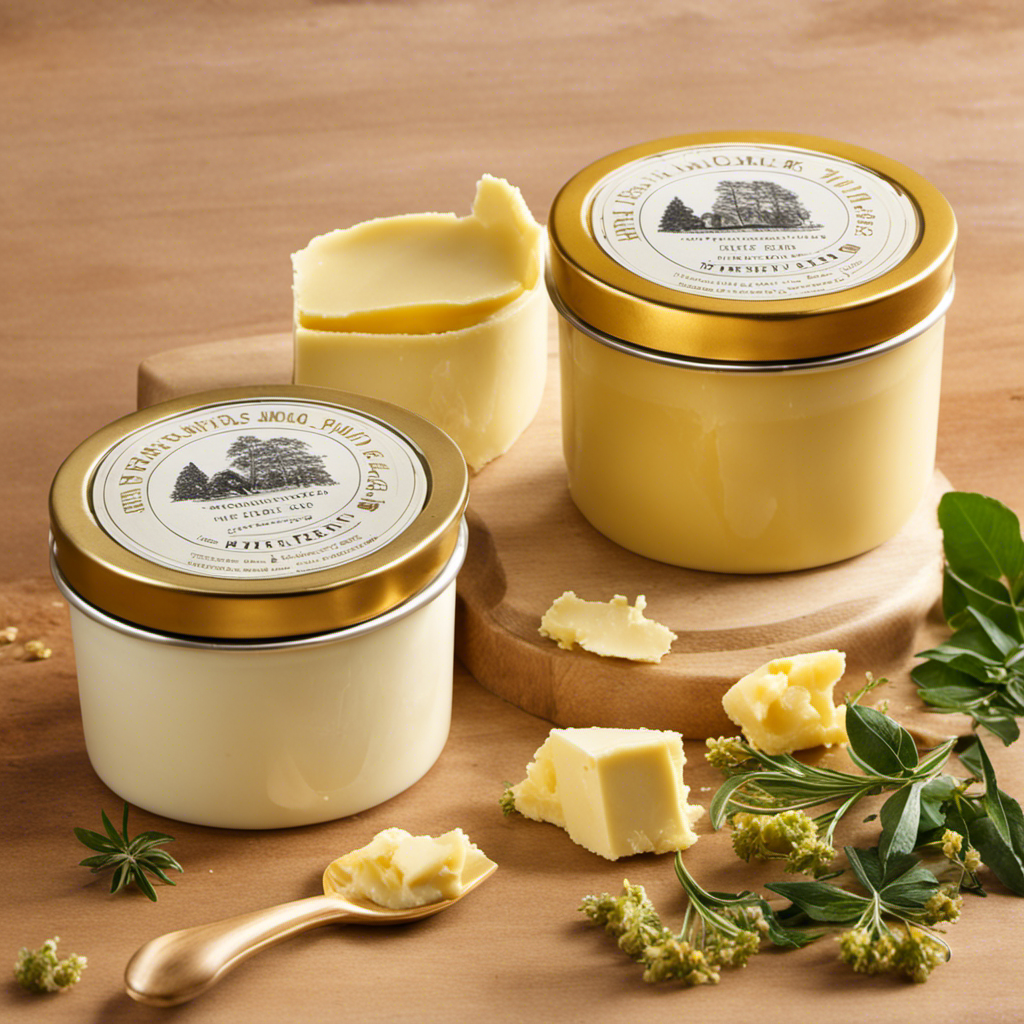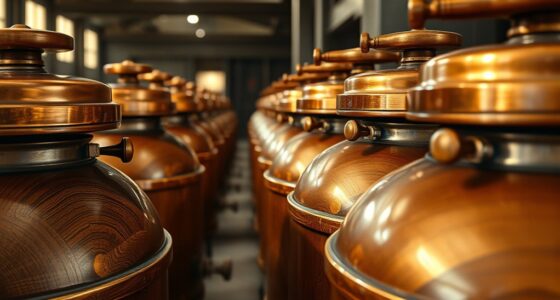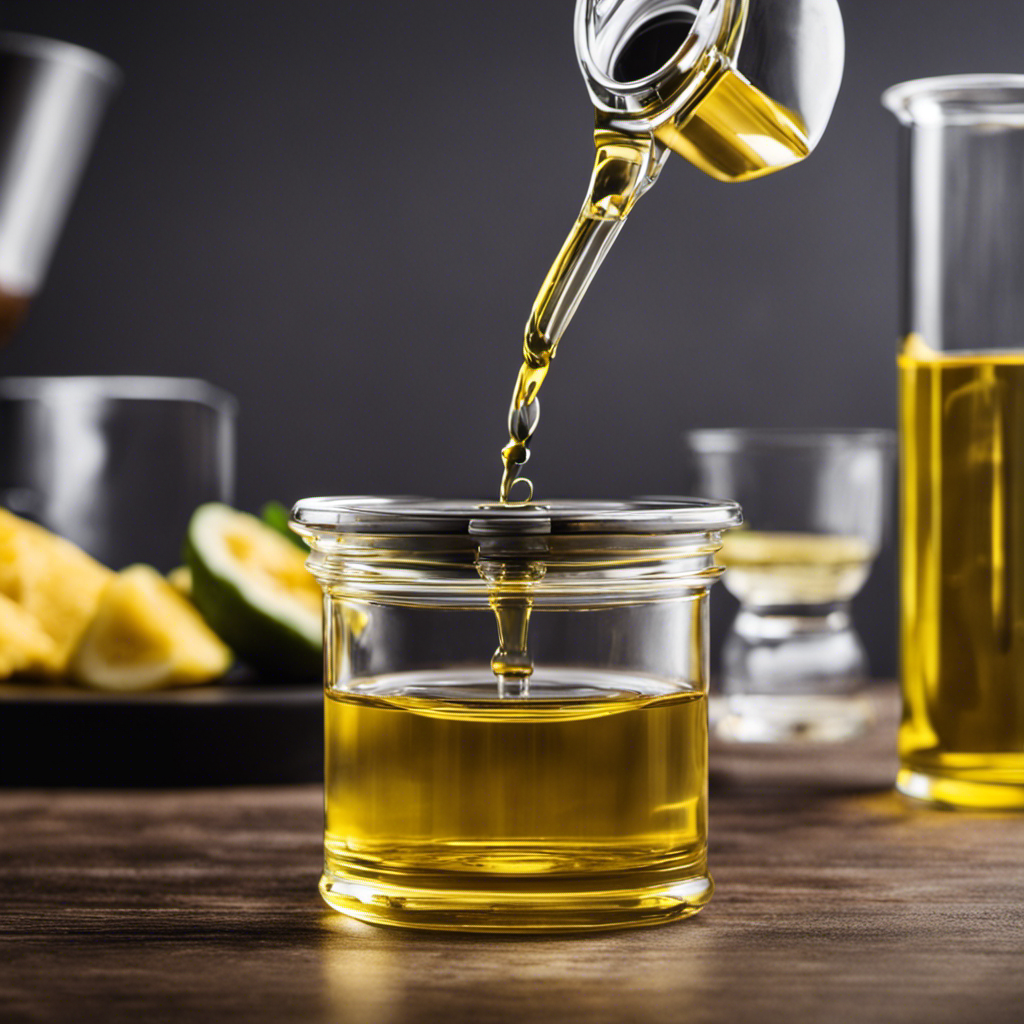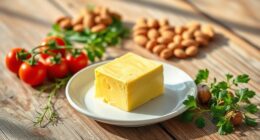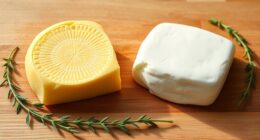The first step in butter production is collecting fresh milk directly from the cow with proper hygiene practices to guarantee its quality and safety. You should design a comfortable, stress-free milking environment, sanitize equipment before use, and handle the milk gently. After collection, keep the milk in a cool, hygienic storage area before transporting it to the processing facility. Continuing will reveal how this process fits into the larger production of delicious butter.
Key Takeaways
- Ensure cows are calm and comfortable to facilitate stress-free milking.
- Design an efficient, hygienic milking station with easy access and gentle handling.
- Properly clean and sanitize milking equipment before use to prevent contamination.
- Collect milk in hygienic containers and store immediately at around 4°C to maintain quality.
- Monitor herd health and milk quality indicators to ensure high-quality raw milk for cream separation.
Collecting Fresh Milk From the Cow
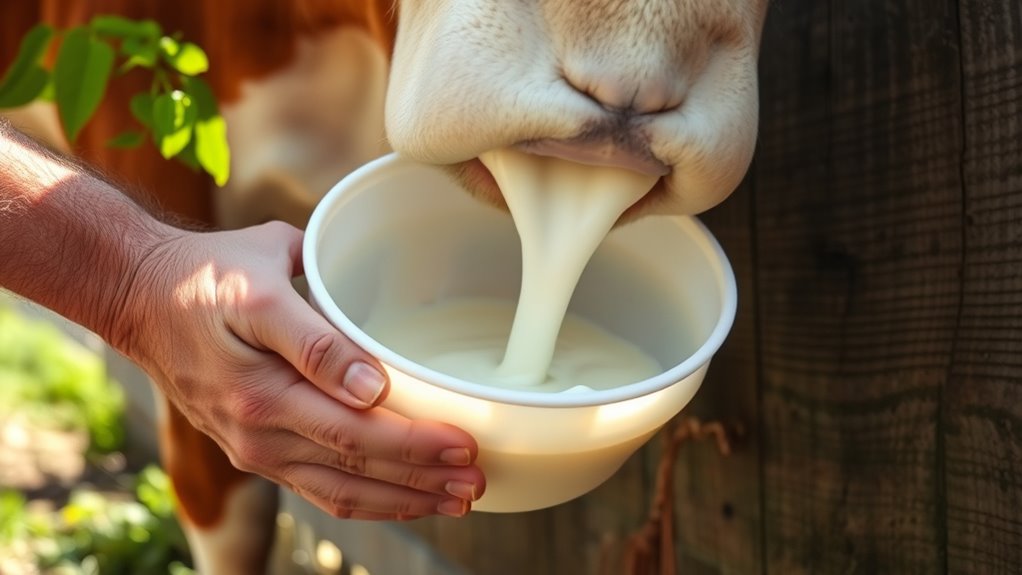
Have you ever wondered how fresh milk makes its way from the cow to your glass? It all starts with understanding cow behavior and designing an efficient milking station. Cows naturally seek comfort and routine, so a well-designed milking station encourages cooperation. You’ll notice that the layout minimizes stress, with easy access and gentle handling. Proper design guarantees cows feel safe and relaxed, making milking smoother. When the cow approaches, gentle prompts and calm surroundings help her cooperate willingly. The station’s layout—featuring comfortable stalls and accessible equipment—streamlines the process. Additionally, incorporating high-quality projectors can aid in monitoring and managing herd health, ensuring consistent milk production. By paying attention to cow behavior and optimizing milking station design, you can collect fresh, high-quality milk efficiently, setting the stage for the next steps in butter production.
Ensuring Proper Milk Hygiene and Handling
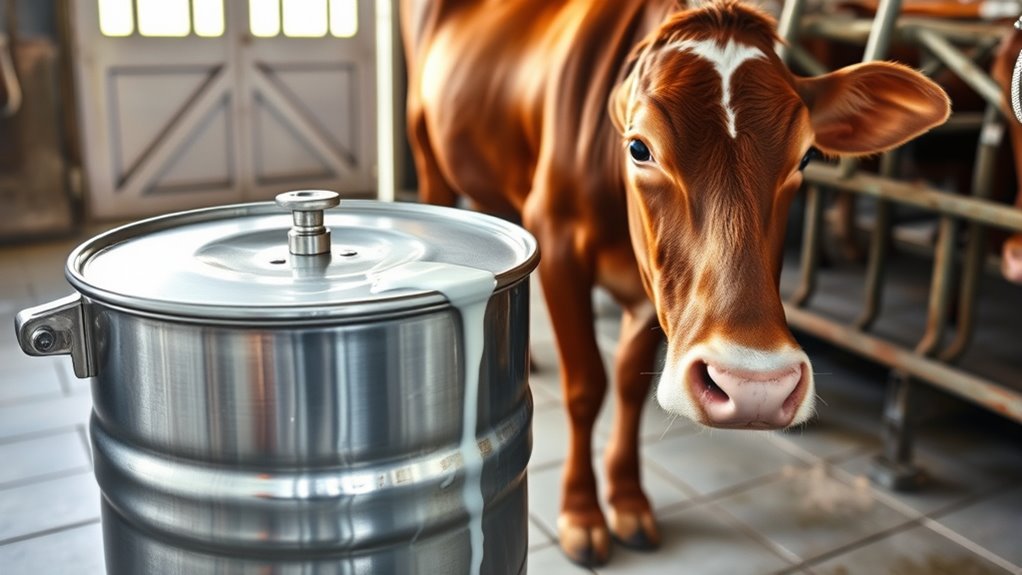
To keep your milk safe, you need to sanitize all milking equipment thoroughly before use. Maintaining cold storage at the right temperature helps prevent bacterial growth, preserving milk quality. Additionally, you should always take steps to prevent contamination risks during handling and transportation. Incorporating AI-driven solutions can further optimize hygiene monitoring and ensure consistent quality control throughout the process.
Sanitize Milking Equipment
Properly sanitizing milking equipment is essential for maintaining milk quality and preventing contamination. Clean dairy equipment ensures hygiene standards are met, reducing bacteria and spoilage risks. To do this effectively, you should:
- Rinse equipment immediately after milking to remove residual milk.
- Use hot water and appropriate cleaning agents to scrub all surfaces.
- Sanitize with approved disinfectants to kill remaining germs.
- Allow equipment to air dry completely before next use.
Following these steps helps you uphold strict hygiene standards, ensuring the milk stays pure and safe. Regular cleaning not only prevents harmful bacteria buildup but also prolongs the lifespan of your dairy equipment. Consistent sanitation is key to producing high-quality milk and maintaining a healthy dairy operation.
Maintain Cold Storage
Maintaining cold storage is essential for preserving milk quality and preventing bacterial growth. When you keep milk at proper temperatures, you slow down bacterial activity that can spoil the milk or cause health issues. Use clean, insulated containers and ensure your refrigeration units are functioning correctly. Regularly check the temperature, aiming for around 4°C (39°F), to guarantee ideal milk preservation. Promptly transfer freshly collected milk into cold storage to limit exposure to warm environments. Avoid leaving milk out in warm conditions for extended periods, as this accelerates spoilage. Proper cold storage not only maintains milk hygiene but also extends shelf life, making it safer for processing into butter. Consistent temperature control is key to ensuring your milk remains fresh and high-quality from farm to production. Additionally, monitoring air quality indicators in storage areas can help maintain optimal conditions and prevent spoilage.
Prevent Contamination Risks
Ensuring proper milk hygiene and handling is crucial to prevent contamination that can compromise quality and safety. To achieve this, focus on contamination prevention through strict practices. First, always clean and sanitize milking equipment thoroughly after each use. Second, store milk in hygienic packaging that prevents exposure to dirt and bacteria. Third, maintain a cold storage environment to inhibit bacterial growth. Fourth, handle milk with clean hands and wear gloves when necessary. Additionally, regularly monitoring market growth projections can help identify emerging best practices for hygiene and quality control. By following these steps, you minimize risks of contamination, ensuring the milk remains safe and of high quality. Proper hygiene and hygienic packaging are essential components in safeguarding milk during the passage from cow to cream separator. This reduces spoilage and guarantees a safe product for butter production.
Transportation of Milk to the Processing Facility
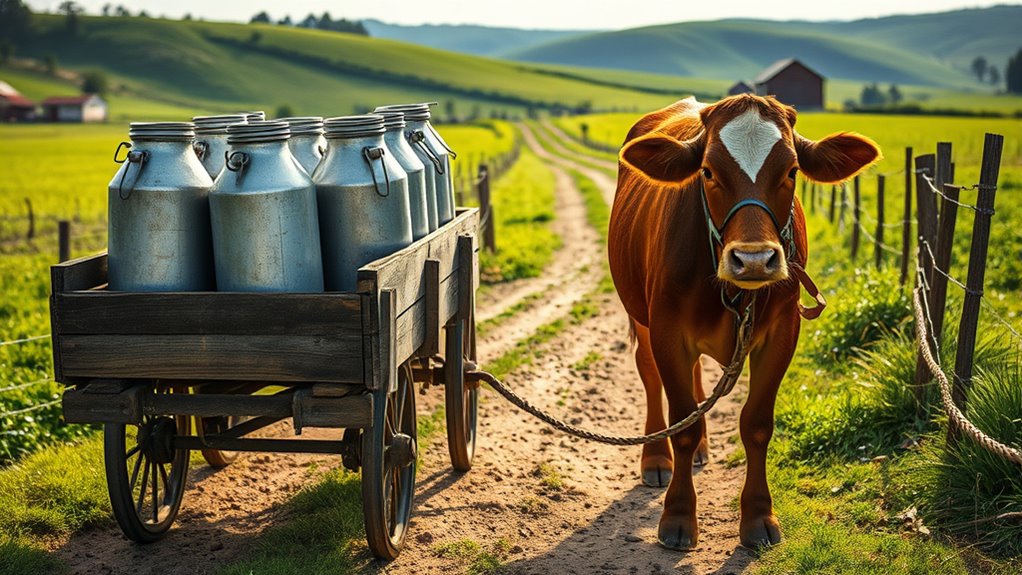
Transporting milk from the farm to the processing facility requires careful handling to maintain its quality and safety. You should guarantee that all dairy vehicles used for milk transportation are thoroughly sanitized to prevent contamination. Proper dairy vehicle sanitation includes cleaning all surfaces that come into contact with the milk and disinfecting them regularly. During milk transportation, keep the milk at the correct temperature to inhibit bacterial growth and preserve freshness. Use insulated tanks to prevent spoilage and protect the milk from external elements. Avoid jostling or rough handling, as this can cause agitation and compromise quality. Consistent monitoring and proper hygiene practices during milk transportation are essential to deliver high-quality raw milk to the processing plant. Additionally, maintaining a clean environment during loading and unloading helps prevent cross-contamination and ensures the integrity of the milk.
Inspection and Testing of Raw Milk Quality
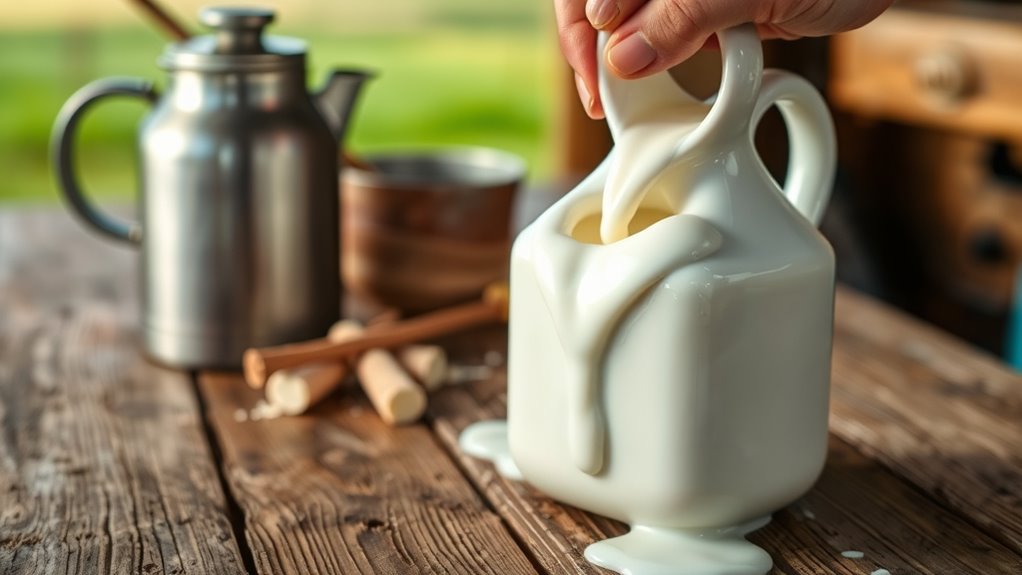
To guarantee the quality and safety of raw milk, thorough inspection and testing are essential steps before processing begins. You should evaluate factors affecting milk composition and ensure it’s free of contaminants. First, check the dairy cattle’s health and cleanliness, as healthy animals produce better-quality milk. Second, analyze the milk for bacterial count to prevent spoilage. Third, test for somatic cell count, which indicates udder health issues. Fourth, assess chemical properties like fat, protein, and lactose levels to ensure proper milk composition. These tests help identify contamination, adulteration, or deviations in milk quality. Additionally, monitoring automation technologies can improve the consistency and efficiency of quality checks. By performing these inspections diligently, you ensure only high-quality raw milk enters the butter production process, safeguarding product quality and consumer safety.
Pasteurization Process for Milk Safety
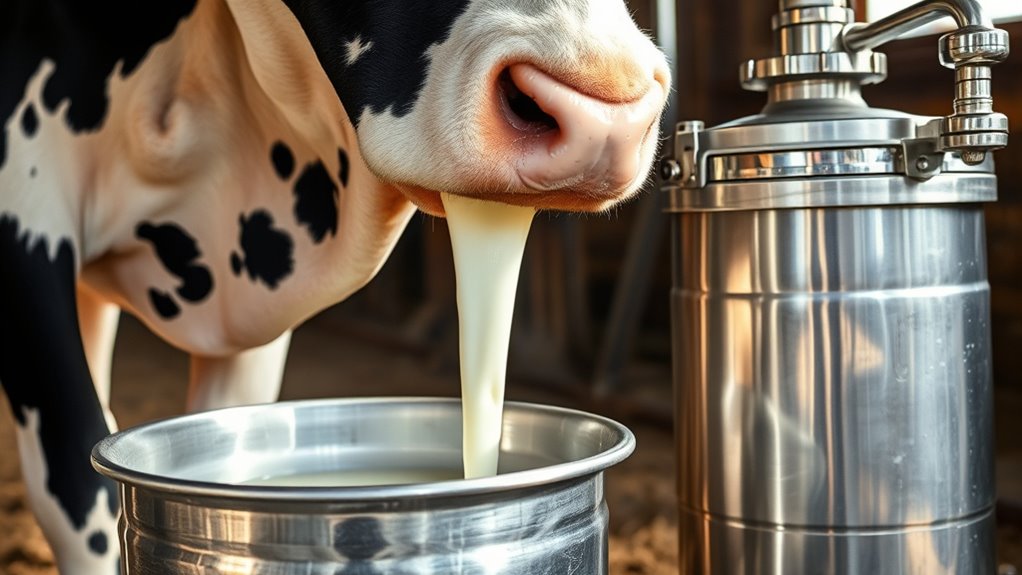
Pasteurization is a crucial step in making raw milk safe for consumption by eliminating harmful microorganisms. Through milk pasteurization, you heat the milk to a specific temperature for a set period, destroying bacteria that could cause illness. This process ensures dairy safety by reducing pathogens like Salmonella, Listeria, and E. coli. You can choose different methods, such as high-temperature short-time (HTST) or low-temperature long-time (LTLT), depending on your equipment and needs. Proper pasteurization not only protects consumers but also extends the milk’s shelf life. It’s an essential step in the dairy industry to guarantee that the milk you produce is safe, clean, and ready for further processing into butter or other dairy products. Additionally, maintaining precise temperature control during pasteurization is vital to ensure effectiveness and prevent spoilage.
Separation of Cream From Milk
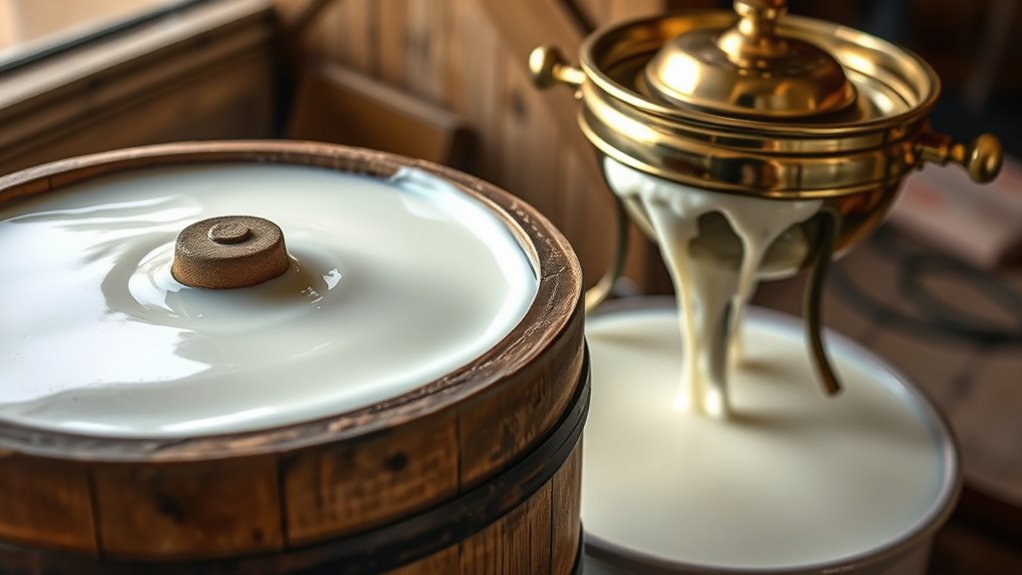
To separate cream from milk, you first let the milk settle so the cream rises naturally. Skimming the cream efficiently requires the right equipment, whether it’s a traditional skimmer or a modern cream separator. Understanding the equipment used helps you choose the best method for quick and effective separation. Remote hackathons can also be useful for gaining insights into innovative equipment and techniques through virtual collaboration.
Milk Settling Process
The milk settling process begins when fresh milk is left undisturbed in a container, allowing the cream to naturally rise to the surface. During this time, milk coagulation may occur as bacteria culture influences the process, affecting how quickly the cream separates. You should monitor factors like temperature and duration to optimize separation. Additionally, understanding the microbial activity involved can help in controlling the quality and efficiency of cream formation.
This process sets the foundation for efficient cream extraction and subsequent butter production.
Skimming Cream Efficiently
Once the cream has naturally risen to the surface during the settling process, you can begin skimming it off efficiently. Use a clean, flat utensil or cream skimmer to gently lift the cream without disturbing the milk below. Maintaining dairy farm cleanliness is vital—any contamination can affect cream quality. Though homogenization techniques are often used later to break down fat globules, skimming involves simple separation at this stage. Be sure to work quickly and carefully to prevent mixing the cream back into the milk. Regularly clean your tools to avoid bacteria buildup. Proper skimming ensures you collect the richest, thickest cream, setting a strong foundation for butter-making. Efficiency and cleanliness are key to getting the best cream right from the start. Additionally, understanding the separation process can help optimize cream collection and improve the overall quality of your dairy products.
Equipment for Separation
Using the right equipment makes separating cream from milk more efficient and hygienic. Proper tools ensure you maintain milk hygiene and preserve quality. Essential equipment includes:
- Cream separator machine – speeds up separation and improves consistency.
- Sterilization tools – keep all equipment clean to prevent contamination.
- Cooling tanks – preserve milk freshness before separation.
- Piping and filters – facilitate hygienic transfer and prevent impurities.
Choosing quality cream separators designed for dairy cows’ milk helps you achieve ideal cream recovery. Maintaining hygiene standards with sterilized equipment minimizes bacterial growth, ensuring a safe final product. Properly selected equipment simplifies the process, reduces waste, and enhances the quality of your butter production.
The Role of the Cream Separator Machine
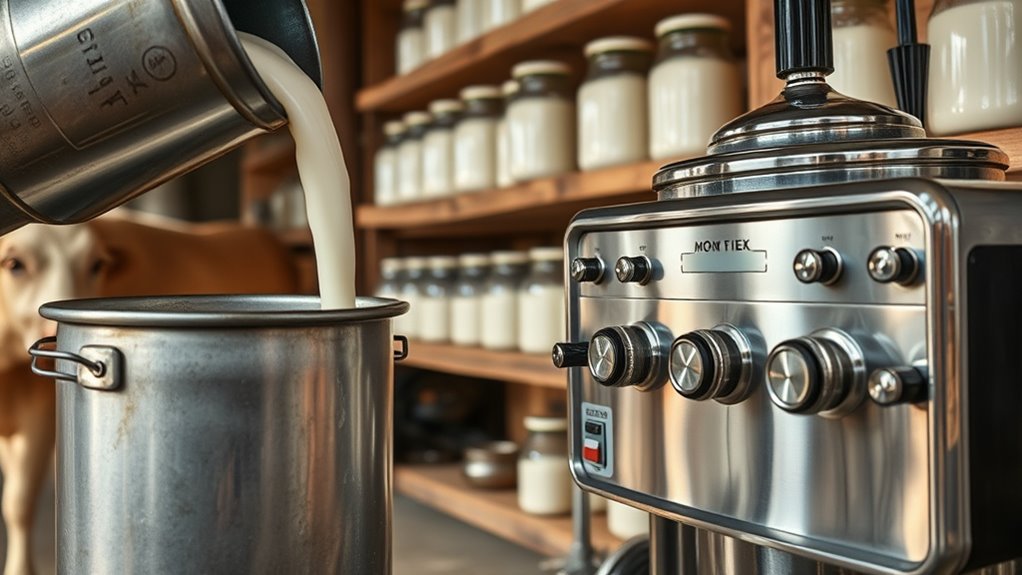
A cream separator machine plays a crucial role in transforming raw milk into valuable dairy products by efficiently isolating cream from the milk. It streamlines the cream separation process, allowing you to produce high-quality cream for butter making. The machine works by spinning the milk at high speeds, using centrifugal force to separate the cream from the skim milk. Proper separator maintenance guarantees peak performance and prolongs the machine’s lifespan. Regular cleaning prevents contamination and keeps the separation process smooth. When you understand the machine’s role, you appreciate its importance in dairy production. By maintaining your separator, you ensure consistent cream quality and improve overall efficiency, making your journey from raw milk to delicious butter more effective and reliable.
Factors Affecting Cream Separation Efficiency
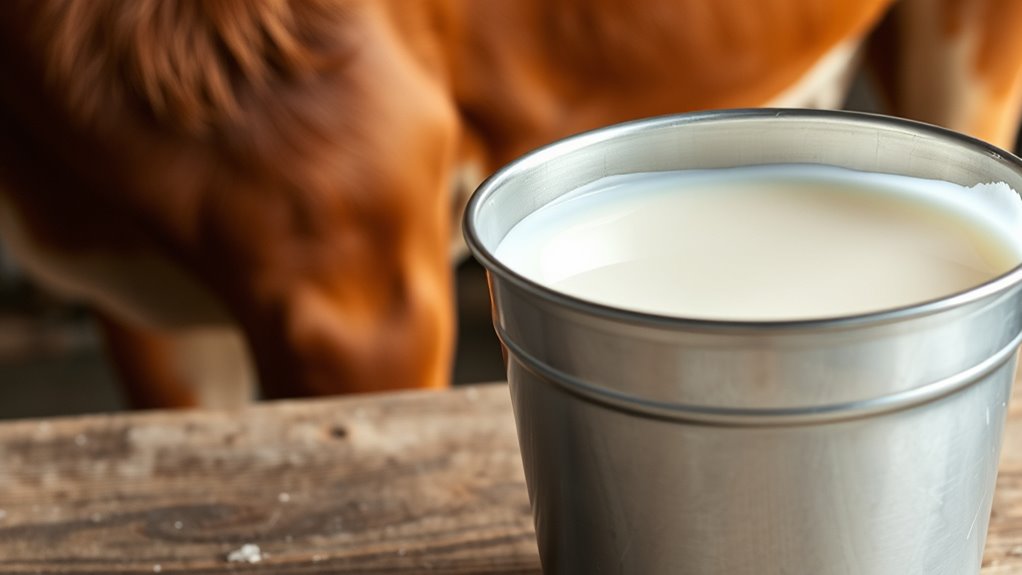
You can improve cream separation by paying attention to milk temperature, as it directly affects how well the cream separates. The quality of the separator design also plays a vital role in achieving high efficiency. Additionally, handling techniques, like proper pouring and cleaning, guarantee your equipment works at its best.
Milk Temperature Control
Controlling milk temperature is essential for maximizing cream separation efficiency because temperature directly influences the fat globules’ behavior and the milk’s viscosity. Proper temperature regulation ensures consistent separation and prevents issues like increased milk acidity that can hinder separation. To refine results, consider these factors:
- Maintain milk at around 4°C to 8°C for ideal fat globule stability.
- Avoid temperature fluctuations that can alter milk acidity, impacting separation quality.
- Use precise temperature regulation devices to prevent overheating, which can cause fat globule breakdown.
- Regularly monitor and calibrate temperature controls to ensure consistency throughout processing.
Separator Design Quality
Have you considered how the design quality of a separator directly impacts cream separation efficiency? The separator design determines how effectively the machine separates cream from skimmed milk. A well-designed separator ensures ideal flow, proper centrifugal force, and minimal loss of cream. Poor design can cause turbulence, uneven separation, or cream contamination. Quality control during manufacturing is essential to ensure the parts fit correctly, bearings are smooth, and the bowl rotates uniformly. Features like adjustable settings for fat content and efficient discharge systems also influence performance. Investing in a high-quality separator with precise design reduces energy consumption and improves yield. Ultimately, paying attention to separator design quality helps you produce consistent, high-quality cream, making your butter production process more efficient and profitable.
Proper Handling Techniques
Proper handling techniques play a vital role in maximizing cream separation efficiency. When engaging in homemade dairying, careful management ensures high-quality milk and better cream extraction. To enhance results, consider these key practices:
- Maintain consistent milking routines to reduce stress and improve milk quality.
- Ensure cows are healthy and well-fed, supporting ideal milk composition for separation.
- Use clean equipment to prevent contamination that can hinder cream separation.
- Store milk at proper temperatures before processing to preserve cream layers and prevent spoilage.
Storage of Separated Cream Before Further Processing
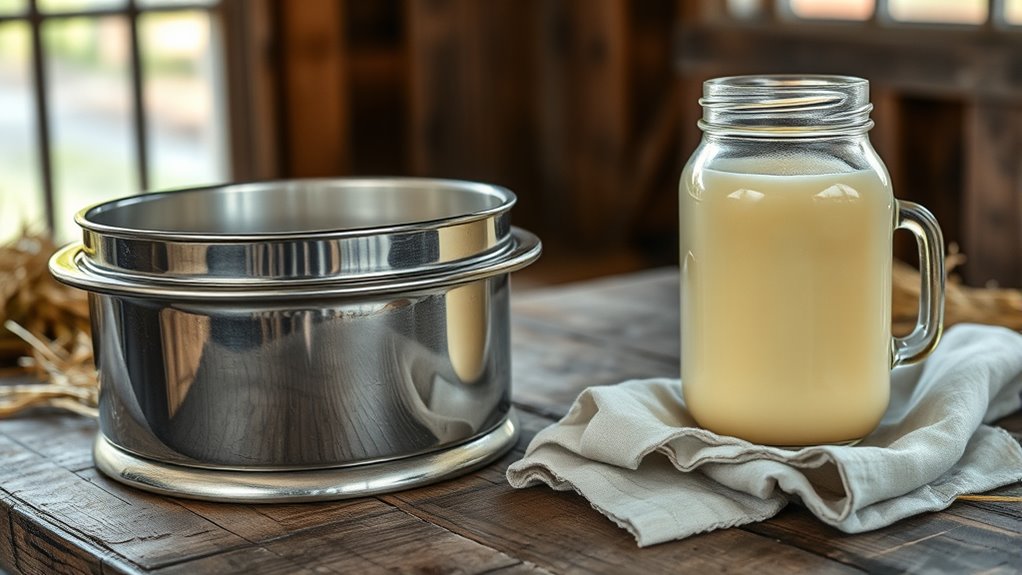
Once the cream has been separated, storing it correctly is essential to preserve its quality before further processing. Proper cream storage involves maintaining consistent temperature regulation to prevent spoilage and bacterial growth. Keep the cream in a clean, airtight container to avoid contamination and exposure to light, which can degrade its quality. Ideally, store the cream at temperatures between 1°C and 4°C (34°F and 39°F). If you can’t refrigerate immediately, use a cool, shaded area temporarily. Regularly check the storage environment to ensure the temperature remains stable. Avoid overfilling containers, as proper airflow helps maintain uniform cooling. Effective cream storage preserves freshness, flavor, and texture, ensuring the cream remains suitable for the next steps in butter production.
Preparing the Cream for Butter Production

Before you begin transforming the stored cream into butter, it’s important to bring it to the right temperature. Proper temperature control ensures a smooth churning process and high-quality butter. To prepare, consider these key steps:
- Allow the cream to warm to around 60°F (15°C), matching the temperature of the dairy cow’s milk for ideal fat separation.
- Gently stir or agitate the cream to redistribute fat globules, especially if it’s been stored for a while.
- Check the cream’s consistency—thick but pourable—before proceeding.
- Keep in mind that higher milk yield from your dairy cow can influence cream fat content, affecting the butter’s texture and flavor. Proper preparation guarantees consistent results in butter production.
Frequently Asked Questions
How Long Does It Take to Produce Butter From Cow’S Milk?
You can typically produce butter from cow’s milk in about 1 to 2 hours, depending on factors like milk fermentation and churn timing. Once you’ve collected fresh milk, you let it ferment slightly, which helps develop flavor. Then, churning separates the butter from buttermilk. The entire process varies based on temperature and equipment, but with proper timing, you’ll have fresh butter ready in just a short while.
What Are Common Challenges in Cream Separation?
Ever wondered what makes cream separation tricky? You face challenges like inconsistent milk fat content, which affects separator efficiency. Variations in milk composition, temperature fluctuations, and equipment issues can reduce separation quality. Are you prepared to optimize your process? By maintaining precise temperature control and regular equipment checks, you can improve separator efficiency, ensuring a cleaner separation and higher-quality cream for buttery success.
Can Different Cow Breeds Affect Cream Quality?
Breed differences can markedly affect cream quality because different cow breeds produce milk with varying composition. You’ll notice that some breeds, like Jersey or Guernsey, tend to produce milk richer in fat and solids, which enhances cream quality. Understanding these variations helps you select the right breed for better cream separation and ultimately, a higher quality butter. So, breeding choices directly influence the milk’s composition and the final product’s quality.
How Is Milk Quality Monitored During Processing?
You monitor milk quality through rigorous milk testing, guaranteeing each batch meets safety standards, checking for contaminants, and verifying composition. You also implement contamination control measures, maintaining hygiene throughout processing, to prevent spoilage and ensure purity. By consistently applying these practices, you safeguard the milk’s quality from farm to processing, ensuring that only high-quality milk proceeds to the next stage, preserving flavor, safety, and overall product excellence.
What Are Eco-Friendly Practices in Butter Production?
You can adopt eco-friendly practices in butter production by prioritizing sustainable sourcing of ingredients and materials, ensuring they come from environmentally responsible sources. Waste reduction is key; you might reuse or recycle by-products and optimize processes to minimize waste. Using renewable energy sources, such as solar or wind power, also helps reduce your carbon footprint. These steps make your butter-making process greener, aligning with eco-conscious values and supporting a healthier planet.
Conclusion
By understanding each step from cow to cream separator, you guarantee high-quality butter production. Did you know that about 98% of milk’s fat can be efficiently separated with modern cream separators? This highlights how vital proper separation is in maximizing butter yield. When you pay attention to hygiene, testing, and technology, you’re not only producing better butter but also safeguarding consumer health. Keep refining your process—your efforts make a delicious difference!
